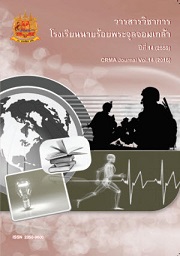กรอบการทำงานของระบบการจัดการความรู้ฟาร์มอัจฉริยะ
Main Article Content
บทคัดย่อ
บทความนี้มีวัตถุประสงค์หลักเพื่อนำเสนอแนวทางให้เป็นไปตามกรอบของหลักวิชาการในการศึกษางานวิจัยที่เกี่ยวข้อง การวิเคราะห์วิธีวิจัย และการหาแนวทางพัฒนาระบบ เพื่อนำมาสรุปกรอบการทำงานของการพัฒนาระบบจัดการความรู้เพื่อเป็นกรอบแนวทางในการพัฒนาระบบจัดการความรู้ในฟาร์มอัจฉริยะ ในการที่จะมุ่งไปสู่การยกระดับมาตรฐานการเกษตร โดยระบบจะต้องสามารถเก็บรวบรวม การประมวลผล การเก็บรักษา และการเผยแพร่ข้อมูลในรูปแบบของสารสนเทศที่จำเป็นไปใช้สำหรับการปฏิบัติงานในฟาร์มอัจฉริยะ
Article Details
ผลงานที่ได้รับการตีพิมพ์ ถือเป็นลิขสิทธิ์ของวารสารฯ
เอกสารอ้างอิง
Sarka, H, Karel C,Miguel Ángel E, Walter M, Antonio C, Raul P., 2014. FOODIE – Open Data for Farmers [Online] http://www.foodie-project.eu/
Wong, D. M. L., 2010. Knowledge Management Catalyst for Sustainable development. ITSim 2010 (3), 1444-1449.
Mohamed, M., Stankosky, M., & Mohamed, M., 2009. An empirical assessment of knowledge management criticality for sustainable development. Journal of Knowledge Management, 13(5), 271 – 286.
Lwoga, E.T, Ngulube, P. & Stilwell, C., 2010. Managing indigenous knowledge for sustainable agricultural development in developing countries: Knowledge management approaches in the social context. The International Information & Library Review, 42(3).
Salami, P., Ahmadi, H., 2010. Review of Farm management Information Systems (FMIS). New York Sci J 3 (5), 87–95.
Beck, H., 2001. Agricultural enterprise information management using object databases, Java, and COBRA. Comput. Electron. Agric. 32 (2), 119–147.
Nikkilä, R., Seilonenen, I., Koskinenen, K., 2010. Software architecture for farm management information systems in precision agriculture. Comput. Electron. Agric. 70 (2), 328–336.
Sorensen, C.G., Fountas, S., Nash, E., Pesonen, L., Bochtis, D., Pedersen, S.M., Basso, B., Blackmore, S.B., 2010. Conceptual model of a future farm management information system. Comput. Electron. Agric. 72 (1), 37–47.
Alavi, M. & Leidner, D.E., 2001. Knowledge Management and Knowledge Management systems: Conceptualization and research issues, MIS Quarterly, 25(1), 107-136.
Fernandez, B., Gonzalez, A., & Sabherwal, R. , 2004. Knowledge management: Challenges solutions and technologies. Pearson Prentice Hall, New Jersey USA.
Liao, S, 2003. Knowledge management technologies and applications--literature review from 1995 to 2002. Expert Systems with Applications, Vol. 25, No. 2. (August 2003), pp. 155-164.
Polanyi, M., 1966. The Tacit Dimension. Routledge & Kegan Paul, London.
Nonaka, I., 1991. The Knowledge Creating Company. Harvard Business Review. Nov-Dec 1991.
Bruckmeier, K., & Tovey, H., 2008. Knowledge in Sustainable Rural Development: From Forms of Knowledge to Knowledge Processes. European Society for Rural Sociology, Vol. 48, p 313-329.
Ashraf, M.M. & Malik, B.T., 2011. Gonokendra model: a response to “information poverty” in rural areas of Bangladesh.Information Technology for development. 17(2), 153-161.
Brown, B. J., Hanson, M. E., Liverman, D.W., 1987. Global sustainability: Toward definition, Environmental Management. 11(6), 713-719.
Robertson, S., 2004. Scenarios in requirements discovery. In: Alexander, Maiden (Eds.), Scenarios, Stories, Use Cases: Through the System Development Life-Cycle. John Wiley & Sons, Chichester, UK.
Carroll, J.M., 1995. Introduction: the scenario perspective on the system development. In: Carroll, J.M. (Ed.), Scenario-based Design: Envisioning Work and Technology in System Development. Wiley, New York.
Alexander, I., 2004. Introduction: scenarios in system development. In: Alexander, Maiden (Eds.), Scenarios, Stories, Use cases: Through the System Development Life-Cycle. John Wiley & Sons, Chichester, UK.
Walsham, G., 1995. Interpretive case studies in IS research: nature and method. European Journal of Information Systems 1995 4, 74-81.


